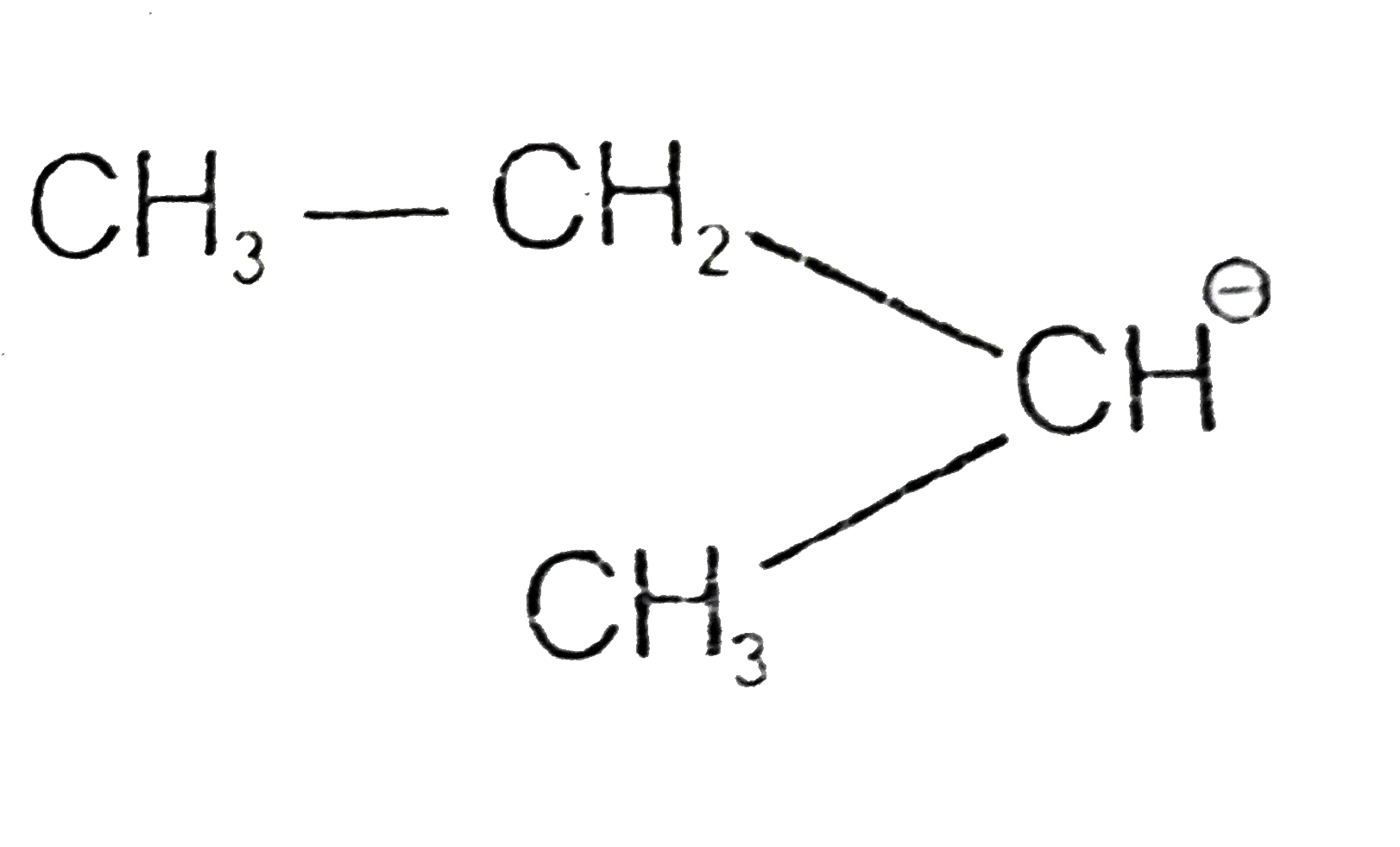Most stable carbanion among the following is
CH3−CH−2

CH3−CH3∣C−∣CH3
All of these
The correct Answer is:A
To determine the most stable carbanion among the given options, we need to analyze the structure of each carbanion and the effects of the surrounding groups on the stability of the negative charge.
1. Identify the Carbanions:
- Option A: CH3CH2- (ethyl carbanion)
- Option B: CH3CH2CH-CH3 (butyl carbanion)
- Option C: CH3C-CH3 (isopropyl carbanion)
- Option D: All of these
2. Understand Carbanion Stability:
- Carbanions are negatively charged species where the negative charge is localized on a carbon atom. The stability of carbanions is influenced by the electron-donating or electron-withdrawing effects of substituents attached to the carbon atom bearing the negative charge.
3. Evaluate Inductive Effects:
- Alkyl groups are electron-donating due to their +I (inductive) effect. The more alkyl groups attached to the carbon with the negative charge, the greater the electron density at that carbon, which can destabilize the carbanion.
4. Analyze Each Option:
- Option A (CH3CH2-): There is one alkyl group (ethyl), which has a minimal +I effect. This carbanion is relatively stable.
- Option B (CH3CH2CH-CH3): There are two alkyl groups (butyl), which exert a stronger +I effect than option A, making it less stable than option A.
- Option C (CH3C-CH3): There are three alkyl groups (isopropyl), which exert the strongest +I effect among the three options, making it the least stable carbanion.
- Option D (All of these): This option suggests that all carbanions are equally stable, which is incorrect based on the analysis.
5. Conclusion:
- The most stable carbanion is Option A (CH3CH2-) because it has the least inductive effect from alkyl groups, resulting in a more stable negative charge.
Final Answer:
The most stable carbanion among the following is Option A (CH3CH2-).
---
- Option A: CH3CH2- (ethyl carbanion)
- Option B: CH3CH2CH-CH3 (butyl carbanion)
- Option C: CH3C-CH3 (isopropyl carbanion)
- Option D: All of these
- Carbanions are negatively charged species where the negative charge is localized on a carbon atom. The stability of carbanions is influenced by the electron-donating or electron-withdrawing effects of substituents attached to the carbon atom bearing the negative charge.
- Alkyl groups are electron-donating due to their +I (inductive) effect. The more alkyl groups attached to the carbon with the negative charge, the greater the electron density at that carbon, which can destabilize the carbanion.
- Option A (CH3CH2-): There is one alkyl group (ethyl), which has a minimal +I effect. This carbanion is relatively stable.
- Option B (CH3CH2CH-CH3): There are two alkyl groups (butyl), which exert a stronger +I effect than option A, making it less stable than option A.
- Option C (CH3C-CH3): There are three alkyl groups (isopropyl), which exert the strongest +I effect among the three options, making it the least stable carbanion.
- Option D (All of these): This option suggests that all carbanions are equally stable, which is incorrect based on the analysis.
- The most stable carbanion is Option A (CH3CH2-) because it has the least inductive effect from alkyl groups, resulting in a more stable negative charge.
The most stable carbanion among the following is Option A (CH3CH2-).
Topper's Solved these Questions
- ORGANIC CHEMISTRY: SOME BASIC PRINCIPLE AND TECHNIQUESBook:AAKASH INSTITUTE ENGLISHChapter:ORGANIC CHEMISTRY: SOME BASIC PRINCIPLE AND TECHNIQUESExercise:SECTION-B OBJECTIVE TYPE QUESTION (ONE OPTION IS CORRECT)
Explore 37 Videos
- ORGANIC CHEMISTRY: SOME BASIC PRINCIPLE AND TECHNIQUESBook:AAKASH INSTITUTE ENGLISHChapter:ORGANIC CHEMISTRY: SOME BASIC PRINCIPLE AND TECHNIQUESExercise:SECTION-C OBJECTIVE TYPE QUESTION (MORE THAN ONE OPTIONS ARE CORRECT)
Explore 18 Videos
- ORGANIC CHEMISTRY: SOME BASIC PRINCIPLE AND TECHNIQUESBook:AAKASH INSTITUTE ENGLISHChapter:ORGANIC CHEMISTRY: SOME BASIC PRINCIPLE AND TECHNIQUESExercise:ILLUSTRATION
Explore 3 Videos
- ORGANIC CHEMISTRY : SOME BASIC PRINCIPLES AND TECHNIQUES Book:AAKASH INSTITUTE ENGLISHChapter:ORGANIC CHEMISTRY : SOME BASIC PRINCIPLES AND TECHNIQUES Exercise:Assignment(Section-D)(Assertion - Reason Type Questions)
Explore 15 Videos
- POLYMERSBook:AAKASH INSTITUTE ENGLISHChapter:POLYMERSExercise:ASSIGNMENT (SECTION-D)
Explore 13 Videos
Similar Questions
Knowledge Check
Most stable carbocation among the following is :
A B
B C
C D⊕CH3
D⊕CH3
Thermally most stable carbonate among the following is
View SolutionWhich is the most stable carbocation among the following ?
View SolutionThe most stable carbocation amongst the following is
View SolutionMost stable radical among the following is
View SolutionMost stable radical among the following is :
View SolutionThe most stable radical among the following is
View SolutionThe most stable radical among the following is :
View Solution